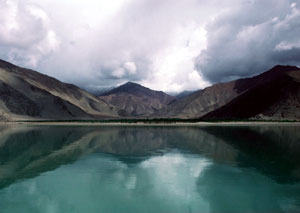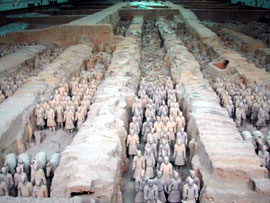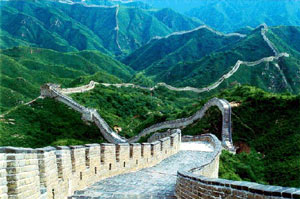|
|
|
|
Top China Destinations:
Shanghai hotels Beijing hotels Guangzhou hotels Hangzhou hotels Shenzhen hotels See more hotels in China
World Destinations:
 Guides » China » The Fascinating World of China Guides » China » The Fascinating World of ChinaThe Fascinating World of China
China is a world of its own, a beautiful blend of contemporary shops to incredible grasslands to the inner sanctums that include ruins, temples, caves, peaks, and many wonderful historical sites. China is a magnificent country of epic landscapes, and stunning mountains. You will discover quaint markets, winding roadways, beautiful silks, and the warmest people on the planet. The official name, People’s Republic of China, has a massive population of 1.25 billion with the capital city of Beijing having 13.8 million.
With a history of over 5,000 years, China’s first dynasty was Xia, which is believed to have lasted between 2200 and 1700 BC. During this dynasty, many legends have been born, followed by god-life entities who give agriculture knowledge, hunting, and gifts of life. During the Zhou Period, the belief in Confucianism came, soon to be followed by Taoist. By the Qin Dynasty, which began in 221 BC, the Chinese writing system was developed and the construction on the Great Wall of China began. The Han Dynasty of 206 BC was a time of great military conflict but also the dynasty in which the Three Kingdoms were created.  By 581 BC during the Sui Dynasty, unity again emerged as this dynasty blended in with the Tang Dynasty. This particular dynasty is known as the most prosperous and glorious time in Chinese history. Silk routes were reestablished, the Chinese society was internationalized, Buddhism flourished, and life was good. However, in 960 at the start of the Song Dynasty, things began to change when Confucianism along with commercial and urban revolutions began. The capital of today’s Beijing was established during the Yuan Dynasty under the leadership of Genghis’ grandson, Kublai Khan. By 581 BC during the Sui Dynasty, unity again emerged as this dynasty blended in with the Tang Dynasty. This particular dynasty is known as the most prosperous and glorious time in Chinese history. Silk routes were reestablished, the Chinese society was internationalized, Buddhism flourished, and life was good. However, in 960 at the start of the Song Dynasty, things began to change when Confucianism along with commercial and urban revolutions began. The capital of today’s Beijing was established during the Yuan Dynasty under the leadership of Genghis’ grandson, Kublai Khan.
The next dynasty was the Ming Dynasty, which began in 1368. Interesting, much of the Great Wall of China that we enjoy today was constructed during this dynasty. This dynasty was also a time when the capitals of Beijing and Nanjing were created. Then in 1516, the Portuguese came to China and soon after, a trade mission was developed by the Macau. However, access to the Chinese markets was something that did not happen until much later in 1760. At that time, trade was quite prosperous but more for the Chinese since the amount of silk and tea being purchased by the British was far greater than the wool and spices being purchased by the Chinese. Because of this, the British wanted to balance things out in 1773 with the sale of opium. That decision led to the famous Opium Wars of 1840. Out of the war came treaties in favor of Britain, leading to the cession of Hong Kong and the Treaty of Nanking being signed. Soon, westerners began snatching up land, the Chinese agreed to the Open Door Policy regarding free trade with the United States, and colonial possessions with Laos, Cambodia, and Vietnam evaporated. As you can imagine, the early part of the 20th century was disastrous. Warlords were fighting for imperial power, new philosophies were searched for to replace Confucianism, and the National Revolutionary Army began training. At the same time, the formation of the Chinese Communist Part was formed, and with the death of Sun Yatsen, Communists were divided. Over the years since, China has undergone numerous transformations. At the end of World War II, China was already involved with the Civil War of 1949 at which time the People’s Republic of China (PRC) was founded. Although the PRC started out with China being a bankrupt country, by the 1950s, the people had bonded, inflation had ceased, and land was redistributed. Although there have since been many different leaders and heavy discussions regarding ownership of specific regions, we now see a country that continues to push forward to a better life. When visiting China, you will have the unique opportunity to experience bits and pieces of each dynasty, as seen in ruins, historical sites, and even the current day culture. The Chinese people are amazingly talented, especially when it comes to things such as calligraphy. Considered the highest form of visual art, you will find calligraphy throughout the country, on cave walls, in Buddhist temples, on monuments, used for restaurant menus, and so on. With a simple bush and ink, these individuals can turn ordinary characters into magnificent works of art. The architecture of China is also fascinating to include rural villages, colonial buildings, imperial structures, temples, and more. Many of the places you visit will have on display various artifacts from the Neolithic times, which includes pottery, jade, weaponry, ritual vessels, and earthenware. The official language is Mandarin with about 70% of the population speaking it. However, China is a country of multiple dialects. For example, there are seven primary Cantonese strains. You will also find that literary heritage is extremely important to the Chinese people. With this, there are two main forms. The first is Confucian, the classical form and vernacular, which would include prose from the Ming Dynasty. Performing, Visual, and Fine Arts are also a valued part of the Chinese heritage, especially as seen in the Chinese opera, something spectacular and worth seeing. However, these people are also extremely talented in acrobatics, stylized dance, and martial arts. Finally, the food of China can be wonderful and delicious but you need to keep in mind that these people often eat things westerners would not consider edible. While you can enjoy versions of Cantonese and Chaozhou foods such as cooked meat and vegetables, Sichuan, which consists of delicious, spicy foods like spare ribs, or Shandong and Mandarin foods to include steamed bread and noodles, other dishes are served that are not for those with a squeamish stomach. You definitely want to experience Chinese tea, relaxing and delicious. While you can order beer and wine, remember that Chinese wine is often enhanced with things like pickled snake, lizard, or herb-soaked concoctions. Last Updated: 10/19/2006 3:14:00 PM Mode articles for China Tibet, also known as Xizang, is called the Roof of the World. This land is breathtakingly beautiful, a perfect blend of green grasslands and snow-capped mountains. The atmosphere of Tibet is truly overwhelming
Tibet, also known as Xizang, is called the Roof of the World. This land is breathtakingly beautiful, a perfect blend of green grasslands and snow-capped mountains. The atmosphere of Tibet is truly overwhelming ... continue >>  During the Shang and Zhou Dynasties, slaves were buried alive with their owners and aristocrats who had died. The number of slaves that had to go to an early grave depended on the number of noblemen that died and who
During the Shang and Zhou Dynasties, slaves were buried alive with their owners and aristocrats who had died. The number of slaves that had to go to an early grave depended on the number of noblemen that died and who ... continue >>  One of the greatest wonders of the world is the Great Wall of China. In fact, this structure is so magnificent that it was enlisted in the World Heritage by UNESCO in 1987. You will notice the winding up and down
One of the greatest wonders of the world is the Great Wall of China. In fact, this structure is so magnificent that it was enlisted in the World Heritage by UNESCO in 1987. You will notice the winding up and down ... continue >> |
|
| | |
|
©2025 HotelsRu.com About us Privacy Site map The Fascinating World of China |
|
 Look for deals on hotels?
Look for deals on hotels?